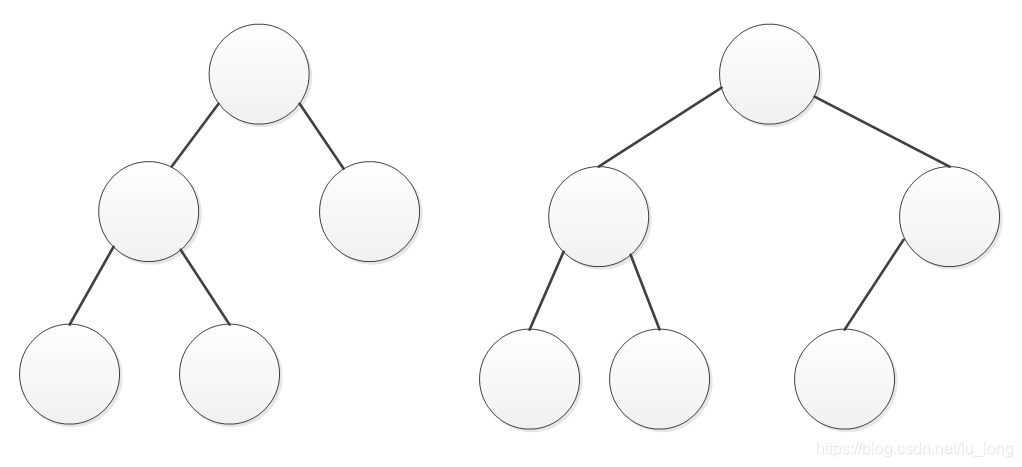基本介绍
- 平衡二叉树也叫平衡二叉搜索树(Self-balancing binary searchtree)又被称为AVL树,可以保证查询效率较高。
- 具有以下特点:它是一棵空树或它的左右两个子树的高度差的绝对值不超过1,并且左右两个子树都是一棵平衡二叉树。平衡二又树的常用实现方法有红黑树、AVL、替罪羊树、Treap、伸展树等。
- 举例说明:

应用案例(一)——单旋转(左旋转)
- 以数列{4,3,6,5,7,8}为例构建一颗平衡二叉树
问题: 当插入8时,rightHeight()-leftHeight()>1成立,此时,不再是一颗AVL树了.
怎么处理 ------ 进行左旋转
1.创建一个新的节点newNode(以4这个值创建),创建一个新的节点,值等于当前根节点的值
//把新节点的左子树设置为当前节点的左子树
2.newNode.left=left
//把新节点的右子树设置为当前节点的右子树的左子树
3.newNode.right =right.left;
//把当前节点的值换为右子节点的值
4.value=right.value;
//把当前节点的右子树设置成右子树的右子树
5.right=right.right;
//把当前节点的左子树设置为新节点
6.left=newLeft;

应用案例(二)——单旋转(右旋转)
- 以数列{10,12,8,9,6}为例构建一颗平衡二叉树
问题: 当插入6时,leftHeight()-rightHeight()>1成立,此时,不再是一颗AVL树了。
怎么处理 ------ 进行右旋转
就是降低左子树的高度。这里是将9这个节点,通过右旋转,到右子树。
1.创建一个新的节点newNode(以10这个值创建)创建一个新的节点,值等于当前根节点的值
//把新节点的右子树设置了当前节点的右子树
2.newNode.right=right
//把新节点的左子树设置为当前节点的左子树的右子树
3.newNode.left =left.right;
//把当前节点的值换为左子节点的值
4.value=left.value;
/把当前节点的左子树设置成左子树的左子树
5.left=left.left;
///把当前节点的右子树设置为新节点
6.right=newLeft;

应用案例(三)——双旋转
- 以数列{10, 11, 7, 6, 8, 9 }为例构建一颗平衡二叉树
问题: 当插入9时,经过左旋转或者右旋转后依旧不是一颗AVL树了。
分析
- 当符号右旋转的条件时
- 如果它的左子树的右子树高度大于它的左子树的高度
- 先对当前这个结点的左节点进行左旋转
- 在对当前结点进行右旋转的操作即可

代码实现
package com.avl;
public class AVLTreeDemo {
public static void main(String[] args) {
// int[] arr = { 4, 3, 6, 5, 7, 8 };
// int[] arr = { 10, 12, 8, 9, 7, 6 };
int[] arr = { 10, 11, 7, 6, 8, 9 };
// 创建AVLTree对象
AVLTree avlTree = new AVLTree();
// 添加结点
for (int i = 0; i < arr.length; i++) {
avlTree.add(new Node(arr[i]));
}
// 遍历
System.out.println("中序遍历");
avlTree.infixOrder();
System.out.println("【平衡处理】");
System.out.println("树的高度=" + avlTree.getRoot().height());
System.out.println("树的左子树高度=" + avlTree.getRoot().leftHeight());
System.out.println("树的右子树高度=" + avlTree.getRoot().rightHeight());
}
}
// 创建AVL树
class AVLTree {
private Node root;
public Node getRoot() {
return root;
}
// 查找要所处的结点
public Node search(int value) {
if (root == null) {
return null;
} else {
return root.search(value);
}
}
// 查找父节点
public Node searchParent(int value) {
if (root == null) {
return null;
} else {
return root.searchParent(value);
}
}
/**
* @Method_Name:delRightTreeMin
* @Description:
* @param node
* 传入的结点(当做二叉排序树的根节点)
* @return int 以node为根节点的二叉排序树的最小结点的值
*/
public int delRightTreeMin(Node node) {
Node target = node;
// 循环查找左节点,就会找到最小值
while (target.left != null) {
target = target.left;
}
// 这是target就指向最小结点
// 删除最小结点
delNode(target.value);
return target.value;
}
// 删除结点
public void delNode(int value) {
if (root == null) {
return;
} else {
// 1.先找到要删除的结点
Node targetNode = search(value);
// 没有找到结点
if (targetNode == null) {
return;
}
// 如果当前二叉排序树只有一个节点
if (root.left == null && root.right == null) {
root = null;
return;
}
// 找到targetNode的父节点
Node parent = searchParent(value);
// 如果要删除的是叶子结点
if (targetNode.left == null && targetNode.right == null) {
// 判断targetNode是父节点的左子节点还是右子节点
if (parent.left != null && parent.left.value == value) {// 是左子节点
parent.left = null;
} else if (parent.right != null && parent.right.value == value) {// 是右子节点
parent.right = null;
}
} else if (targetNode.left != null && targetNode.right != null) {// 删除有两颗子树的结点
int minVal = delRightTreeMin(targetNode.right);
targetNode.value = minVal;
} else { // 删除只有一颗子树的结点
// 如果要删除的结点有左子节点
if (targetNode.left != null) {
if (parent != null) {
// 如果targetNode是parent的左子节点
if (parent.left.value == value) {
parent.left = targetNode.left;
} else {// targetNode是parent的右子节点
parent.right = targetNode.left;
}
} else {
root = targetNode.left;
}
} else {// 要删除的结点有右子节点
if (parent != null) {
// 如果targetNode是parent的左子节点
if (parent.left.value == value) {
parent.left = targetNode.right;
} else {// 如果targetNode是parent的右子节点
parent.right = targetNode.right;
}
} else {
root = targetNode.right;
}
}
}
}
}
// 添加节点
public void add(Node node) {
if (root == null) {
root = node;// 如果root为空直接让root指向node
} else {
root.add(node);
}
}
// 中序遍历
public void infixOrder() {
if (root != null) {
root.infixOrder();
} else {
System.out.println("二叉排序树为空");
}
}
}
// 创建节点
class Node {
int value;
Node left;
Node right;
public Node(int value) {
this.value = value;
}
// 返回左子树的高度
public int leftHeight() {
if (left == null) {
return 0;
}
return left.height();
}
// 返回右子树的高度
public int rightHeight() {
if (right == null) {
return 0;
}
return right.height();
}
// 返回当前节点为根节点的高度
public int height() {
return Math.max(left == null ? 0 : left.height(), right == null ? 0 : right.height()) + 1;
}
// 左旋转方法
private void leftRotate() {
// 创建新节点,以当前根节点创建
Node newNode = new Node(value);
// 把新节点的左子树设置为当前节点的左子树
newNode.left = left;
// 把新节点的右子树设置为当前节点的右子树的左子树
newNode.right = right.left;
// 把当前节点的值换为右子节点的值
value = right.value;
// 把当前节点的右子树设置成右子树的右子树
right = right.right;
// 把当前节点的左子树设置为新节点
left = newNode;
}
// 右旋转
private void rightRotate() {
Node newNode = new Node(value);
newNode.right = right;
newNode.left = left.right;
value = left.value;
left = left.left;
right = newNode;
}
// 查找要删除的结点
/**
* @Method_Name:search
* @Description:查找要删除的结点
* @param value
* 要删除结点的值
* @return Node
*/
public Node search(int value) {
if (value == this.value) {// 找到该节点
return this;
} else if (value < this.value) {// 如果查找的值小于当前节点,向左子树递归查找
if (this.left == null) {
return null;
}
return this.left.search(value);
} else {// 如果查找的值不小于当前节点,向右子树递归查找
if (this.right == null) {
return null;
}
return this.right.search(value);
}
}
// 查找要删除结点的父结点
/**
* @Method_Name:searchParent
* @Description:查找要删除结点的父结点
* @param value
* 要找到的结点的值
* @return Node 返回结点要删除的父结点,没有就返回null
*/
public Node searchParent(int value) {
// 如果当前节点就是要删除结点的父结点,就返回
if ((this.left != null && this.left.value == value) || (this.right != null && this.right.value == value)) {
return this;
} else {
// 如果查找的值小于当前节点的值,并且当前节点的左子结点不为空
if (value < this.value && this.left != null) {
return this.left.searchParent(value);// 向左子树递归查找
} else if (value >= this.value && this.right != null) {
return this.right.searchParent(value);// 向右子树递归
} else {
return null;// 有找到父结点
}
}
}
@Override
public String toString() {
return "Node [value=" + value + "]";
}
// 添加节点
// 递归添加,需要满足二叉排序树的要求
public void add(Node node) {
if (node == null) {
return;
}
// 判断传入结点的值和当前子树的根节点值的关系
if (node.value < this.value) {
if (this.left == null) {
this.left = node;
} else {
// 向左子树添加
this.left.add(node);
}
} else {// 添加的大于当前节点的值
if (this.right == null) {
this.right = node;
} else {
// 向右子树添加
this.right.add(node);
}
}
// 当添加完一个节点后,(右子树的高度-左子树的高度)>1 ,左旋转
if (rightHeight() - leftHeight() > 1) {
// 如果它的右子树的左子树的高度大于它的右子树的右子树的高度
if (right != null && right.leftHeight() > right.rightHeight()) {
// 先对右子结点进行右旋转
right.rightRotate();
// 然后在对当前结点进行左旋转
leftRotate();// 左旋转..
} else {
leftRotate();// 左旋转
}
return;// 必须要
}
// 当添加完一个节点后,(左子树的高度-右子树的高度)>1 ,右旋转
if (leftHeight() - rightHeight() > 1) {
// 如果它的左子树的右子树高度大于它的左子树的高度
if (left != null && left.rightHeight() > left.leftHeight()) {
// 先对当前这个结点的左节点进行左旋转
left.leftRotate();
// 再对当前结点进行右旋转
rightRotate();// 右旋转
} else {
// 进行右旋转
rightHeight();
}
}
}
// 中序遍历
public void infixOrder() {
if (this.left != null) {
this.left.infixOrder();
}
System.out.println(this);
if (this.right != null) {
this.right.infixOrder();
}
}
}
